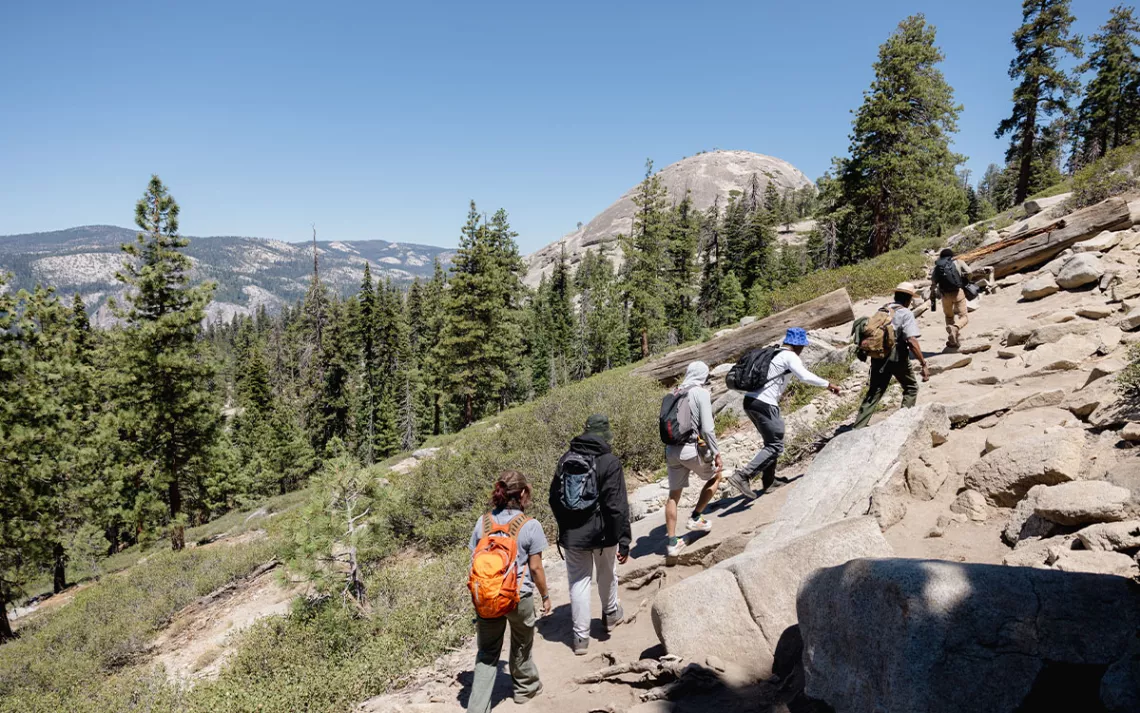Public Lands Transformed: Inside Parks’ Wildfire Recovery
This summer’s park-goers witness the good, the bad, and the surprising

Sugarloaf Ridge State Park | Courtesy of Tony Passantino of Sonoma Ecology Center
Fueled by fire, snowmelt, and sunlight, slender spears of grass pointed upward toward the sun, springing forth from the charred soil of Kawuneeche Valley in Rocky Mountain National Park. From where I stood last May, the altered scene looked like something out of a futuristic sci-fi film. Gone was the park setting I remembered, a lush meadow with towering pines and wispy willows. Before me stretched a vast and vibrant matrix-like pattern of charcoal-blackened ground with patches of neon-green grass poking through.
However shocking at first sight, encouraging evidence of new life was evident. An elk family with a bouncy calf grazed near the charred remains, nibbling at the freshly sprouted field of grass. Seven months after the wildfire, in its first spring, the result of nature’s destruction—and its resiliency—were on full display.
In October 2020, Colorado’s East Troublesome wildfire breached the west entrance of Rocky Mountain National Park after a horrific run through Grand County forests, during which it consumed 356 private homes in its path. Hurricane winds propelled the fire across the Kawuneeche Valley with a fiery fury—the blaze would only be eventually dampened by courageous fire crews and an early-season snowfall.

Rocky Mountain National Park | Courtesy of Gigi Ragland
Drastic changes to iconic landscapes can be unsettling for visitors. Dave Lively, a private tour operator who conducts guided small-group van tours of the west side of Rocky Mountain National Park says that this year, following the East Troublesome wildfire, it’s been especially important to manage expectations with his guests. Before people even get in the van, he discusses the burn areas. “I show my clients pictures of the fire, including aerial pictures from an aircraft demonstrating how immense it was.” Why? To prepare them for what they are about to see, both ugly and beautiful.
“I can’t believe this happened. How did this happen so quickly? It’s so devastating.” These are the comments Lively hears from guests as the van approaches the park entrance. “But as we drive out of the burn about three miles along the road and into the green untouched forest, guest comments revert back to ‘Wow!, I thought it would be so much worse.’”
Lively is one among many national park personnel and tourism pros currently introducing visitors to landscapes that have been drastically altered by recent years' devastating wildfires across the West. Fortunately, there's plenty to learn from the devastation—so much so that some parks and tourism outfitters and guides have added educational fire-recovery programming into their guided and self-guided tours and hikes.
Claiming the title of second-worst wildfire in Colorado history, the East Troublesome was just one of many deadly wildfires that raged through western lands last year. The National Interagency Fire Center reported 58,950 total US wildland fires in 2020. Unbelievably, that’s not a record—the truly sobering takeaway is that they’re getting worse in terms of ferocity and acreage burned. Since 2015, there have been three years during which more than 10 million acres’ worth of total wildland acreage burned. (To put that into perspective, the combined acreage of New Jersey, Delaware, and Rhode Island amounts to just about 10 million acres.)
As the western United States suffers ongoing drought, drier conditions, and rising temperatures, wildfire season, of course, becomes only longer and riskier. Drier and warmer conditions have a domino effect, contributing to the spread of insects that can weaken or kill trees, like the mountain pine beetle. There's also “sudden oak death," which has killed millions of California oaks (ultimately generating more organic fire fuel). In my neck of the woods in Colorado, it’s not uncommon for hikers to observe vast, gray-colored skeletal swaths of dead pine trees that stretch across the Rockies’ otherwise verdant pine forest.
Meanwhile, visitation to parks nationwide is up in the post-pandemic era—which means more outdoor enthusiasts are witnessing fire-recovery efforts and ongoing mitigation efforts in fire-prone areas. As disparaging as the facts seem, proactive measures are, increasingly, being put in place—multiple federal agencies are developing strategies for managing the nation’s flammable landscapes.
One thing public-lands-goers should keep in mind: There’s usually more to a fire-charred area than what meets the eye. If a wildland appears wiped out aboveground—charred and blackened and exhibiting loss of habitat—that’s not necessarily the case underground. Roots of trees, shrubs, flowers, and even living creatures, still occupy the deep soil depths of the forest floor. In many cases, plants depend on fire as a source of regeneration.
 “It was like a phoenix rising from the ashes,” recalls Tony Passantino, education program manager for Sonoma Ecology Center in Eldridge, California, describing the sudden emergence of Whispering Bells, a flower whose seeds germinate soon after a fire and whose roots thereafter spring up from charred areas. “I had never seen them at Sugarloaf Ridge State Park before. But after the fire, there were probably 10 to 50,000 flowers in bloom on this burned hillside. We had lots of people come up to see the flowers.” Passantino leads fire recovery walks within Sugarloaf Ridge State Park, which was scorched by wildfires in 2017 (Nun’s) and 2020 (Glass). Each fire burned about 75 percent of Sugarloaf Ridge State Park’s 4,900 acres. Passantino’s walks focus on how nature benefits from fire and how people can learn from fire ecology.
“It was like a phoenix rising from the ashes,” recalls Tony Passantino, education program manager for Sonoma Ecology Center in Eldridge, California, describing the sudden emergence of Whispering Bells, a flower whose seeds germinate soon after a fire and whose roots thereafter spring up from charred areas. “I had never seen them at Sugarloaf Ridge State Park before. But after the fire, there were probably 10 to 50,000 flowers in bloom on this burned hillside. We had lots of people come up to see the flowers.” Passantino leads fire recovery walks within Sugarloaf Ridge State Park, which was scorched by wildfires in 2017 (Nun’s) and 2020 (Glass). Each fire burned about 75 percent of Sugarloaf Ridge State Park’s 4,900 acres. Passantino’s walks focus on how nature benefits from fire and how people can learn from fire ecology.
In fact, we’ve already come a long way in our relationship with and knowledge of wildfire—thanks to creative fire management endeavors, most of which have replaced an outdated system of fire suppression policies, experts say there’s hope for mitigating the intense wildfires, which are largely fueled by decades of overgrowth in public forests and wildlands.
Michael Elsohn Ross, a longtime (and now retired) Yosemite National Park environmental educator and former park ranger notes, “Left alone, native plants will recover all by themselves after fires.” He explains that the post-fire soils function as seedbeds to fire-following flowers and garden beds for resprouting shrubs. “In areas where many trees have died, the water table will actually rise and ‘normally’ dry creeks will begin to flow, creating new places for flowering plants and ferns to grow.”
Ross says the suppression of fires almost doomed Yosemite’s massive sequoia trees. “The chicken-egg-size cones of these trees release seeds the size of rolled oats that require mineral soil to sprout,” he says. “The sprouts are unable to reach the soil through inches of leaf litter, but after a light fire, when the mineral soil is exposed, the seedlings thrive.” And he maintains that it was only after Yosemite successfully conducted a managed fire in a sequoia grove in the early 1960s that the role of fire in this ecosystem was understood as essential to the creation of the next generation of trees.
For visitors to post-fire landscapes in national parks, Ross offers an encouraging perspective. “In recent years, we’re seeing ‘new’ vista views, where openings in forest have revealed sights not seen since the beginning of fire suppression policies.” These policies started in 1886, when fires in all national parks, starting with Yellowstone, were banned. Suppression rules were later incorporated into the National Parks Act of 1916.
“In Yosemite Valley, paintings and photographs from the 1870s depict waterfalls and cliffs—views that no longer exist due to trees' growth where the forest was once open,” explains Ross. “But the Park Service has been opening these view sheds in the past decade by logging these areas.”
It also bears noting that when a national park or state park is scarred by fire, it doesn’t mean the entire park has been destroyed. A fire might produce a mosaic burn pattern across the landscape, or hopscotch from one point to another, leaving untouched green areas in between.
“The 2017 Eagle Creek Fire that swept through the Columbia River Gorge National Scenic Area created a mosaic of fire effects,” says Steve Kruger, executive director of Trail Keepers of Oregon (TKO). “It was apparent in everything from areas the fire completely missed to large swaths of fast-rolling fire through some areas of the forest understory—which cleaned out shrubs along the forest floor—to those areas where it burned hot and heavy, leaving a moonscape.”
Within three weeks of the burn, the surrounding community rallied—offers to volunteer started pouring into TKO. “We had a list of 5,000 people who wanted to help when the time came to help build back our gorge trails,” says Kruger.
The all-volunteer nonprofit group worked with land managers to scout, assess, and ultimately clear trails that were burned and damaged by wildfire. “A small, skilled, and experienced group of volunteers and staff would enter each new trail segment for the first time with very simple hand tools for brushing and clearing, making it safe and passable for more volunteers and staff to enter,” Kruger says. “Then we’d identify and flag safety concerns observed along the way.”

Photo by Jordan McCauley of Travel Oregon and courtesy of Global Family Travels.
Based on that experience, the organization developed a core fire recovery training program. TKO is currently producing training videos focused specifically on how to recover trails in fire-affected areas.
“A forest in the midst of fire recovery has its own unique beauty that draws people,” says Josh Durham, stewardship coordinator for TKO. “The regenerative process in a burn area encourages growth. As hikers return to the opened trails in the gorge, they will see areas that offer a new perspective on natural beauty, with expansive scenic views. There are now views that you wouldn’t have, up and down the Columbia Gorge, including a really nice view of Mt. St Helen's and a partial view of Mt. Adams.”
When visitors to public lands see burned areas, or have to witness their favorite trails suddenly scorched, Durham recommends reflecting on the natural regenerative process of the land, such as the Columbia Gorge’s renewal of conifer and wildflower growth (a result of the fact they now have enough sunlight). “The forest is still very much alive and cycling through.”
I’ll be taking my own self-guided fire recovery tour this summer in Rocky Mountain National Park, scouting out new growth and wildlife within the open areas. Perhaps I’ll see chipmunks scurrying through the meadows along with the return of the elk and moose. Experts say flower growth here should be prolific in the next few years, due to the fire having jump-started seed germination. If I’m lucky, maybe the purple and white Columbine, the state flower, will make an appearance. Or maybe the Kawuneeche Valley will showcase species I and other locals have never seen—I heard someone say that it could someday become the new “wildflower capital of Colorado.” What a nice surprise that would be, the sight of a recovered high mountain valley, carpeted with a rainbow of wildflowers.
 The Magazine of The Sierra Club
The Magazine of The Sierra Club



